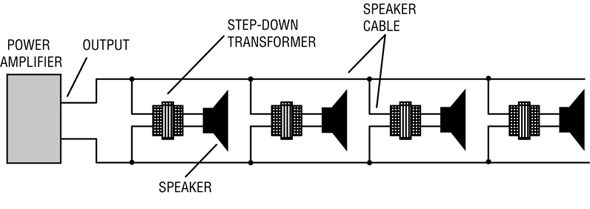
PRECAUTIONS
Since a 70V line is relatively high-impedance, it is more sensitive to partial shorts than a low-impedance line. Consequently, you may want to avoid running 70V lines in underground conduit which may leak water.
Use high-quality transformers with low insertion loss. Otherwise, the power loss in the transformer itself may negate the value of the 70V system.
Avoid driving small transformers past their nominal input voltage rating. Otherwise, they will saturate, draw more than the indicated power (possibly overload the amplifier) and will distort the signal.
You may want to insert a high-pass filter ahead of the power amplifier to prevent strong low-frequency transients which can cause core saturation.
The CTs amplifiers include a high-pass filter that can be selected at 70 Hz, 35 Hz, or bypass. The CH amplifiers insert a 70 Hz high-pass filter when placed in high-impedance mode.
POWER-AMPLIFIER OPTIONS
As stated earlier, there are three power-amplifier options for 70V operation: The amplifier might have:
• an external step-up transformer
• a built-in step-up transformer
• a high-voltage, transformerless output
Let’s consider each option.
Amplifier with external transformer
This system is shown in Figure 1 (on page 1). If you use an external transformer, select one recommended or supplied by the amplifier manufacturer.
If you have a conventional amplifier with low-impedance outputs only, and you want 70V or 100V operation, Crown has the needed accessories. The TP-170V is a panel with four built-in autoformers that convert four low-impedance outputs to high impedance. The T-170V is a single autoformer for the same purpose.
Choose a transformer with a power rating equal to or exceeding the wattage of the power amplifier. The turns ratio should be adequate to provide 70.7V at the secondary when full sine-wave power is applied to the primary. Use the following formula for a 70.7V line:
where
T = turns ratio
70.7 = voltage of constant-voltage line
P = amplifier power output in watts
Z = amplifier rated impedance
SQR means square root
Better yet, measure the amplifier’s output voltage at full power into its rated load impedance, and use the formula:
where
T = turns ratio
70.7 = voltage of constant-voltage line
E = measured output voltage at full power into the rated impedance.
Amplifier with built-in transformer
If the transformer is already built into the power amplifier, simply look for the output terminal labeled “70V,” “25V,” “100V,” or “high impedance.”
Amplifier with transformerless, high-voltage output
Figure 2 shows how a power amplifier with a high output voltage can power a distributed system without a step-up transformer.
Many high-power amplifiers can drive 70V lines directly without an output transformer. For example, Crown CH amplifiers have an auto transformer (except CH 4). CTs amplifiers can provide direct constant-voltage (70V/100V/140V/200V) or low-impedance (2/4/8 ohm) operation.
In Dual Mode, the CTs 600/1200 can power 25/50/70V lines; the CTs 2000/3000 can power 25/50/70/100V lines. In Bridge-Mono mode, the CTs 600/1200 can power 140V lines; the CTs 2000/3000 can power 140V and 200V lines.
With CTs Series amps, one channel can drive low-impedance loudspeakers, while another channel drives loudspeakers with 70V transformers. This makes it easy to set up a system with large, low-Z loudspeakers for local coverage and distributed 70V loudspeakers for distant rooms—all with a single amplifier.
The Crown CTs 2000 adept at providing constant power levels into various loads. In dual mode, it delivers 1000 watts into 2/4/8 ohms and into a 70V line. In bridge-mono mono, it delivers 2000 watts into 4, 8, or 16 ohms, 2000 watts into a 140V line, and 2000 watts into a 200V line.
Crown Commercial Audio series of amplifiers and mixer-amps provide both low-Z and constant-voltage operation. For example, the 180MA and 280MA mixer-amps offer 4-ohm, 70V and 100V outputs.



